The last few months have seen a flurry of activity in downtown New Orleans, with most of the improvements focused on the area between the Superdome and the French Quarter.
The new Loyola Avenue streetcar, a $45 million project, took center stage last week, with elected officials jostling for face time while aboard the 1.5-mile inaugural run.
Using the Superdome as the center of the compass, a scenic two-mile walk will take you past the heart of the French Quarter, with restaurants, bars, shops and activity every step of the way.
A much shorter walk takes you to a very different New Orleans: Central City and the adjacent Tulane-Gravier district. Here, residents still struggle with the double-whammy dealt by Hurricane Katrina and generations of poverty.
The evidence of economic vitality includes the colossal bio-medical complex and the new Home Depot outlet, a post-Katrina project back in the spotlight, what with former Mayor Ray Nagin ’s recent indictment. The 21 counts of alleged corruption portray a mayor far more attentive to his own business opportunities than to the needs of these or any other New Orleans communities.
On Central City’s Clio Street the rails of a long abandoned streetcar are still visible beneath the macadam. The Clio line, also known as the C-L-10, connected Central City with New Orleans’ Uptown district by way of Claiborne Avenue. But service ended in 1932, according to historian Michael Mizell-Nelson.
As these pictures demonstrate, you’re still within sight of the Superdome, but have no doubt about it: The tracks may be nonexistent, but you’re on the wrong side of them.

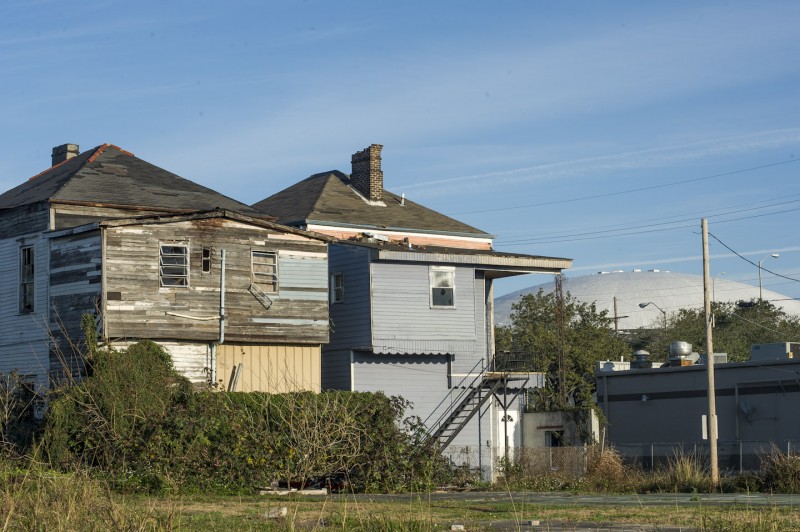

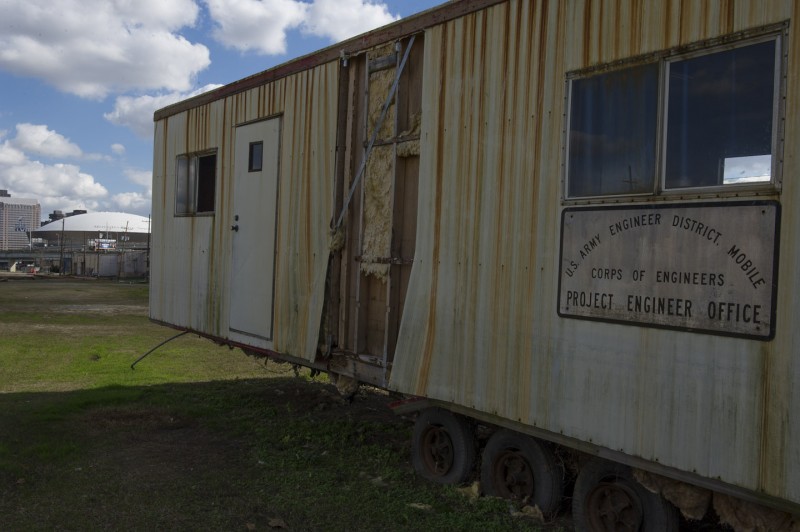
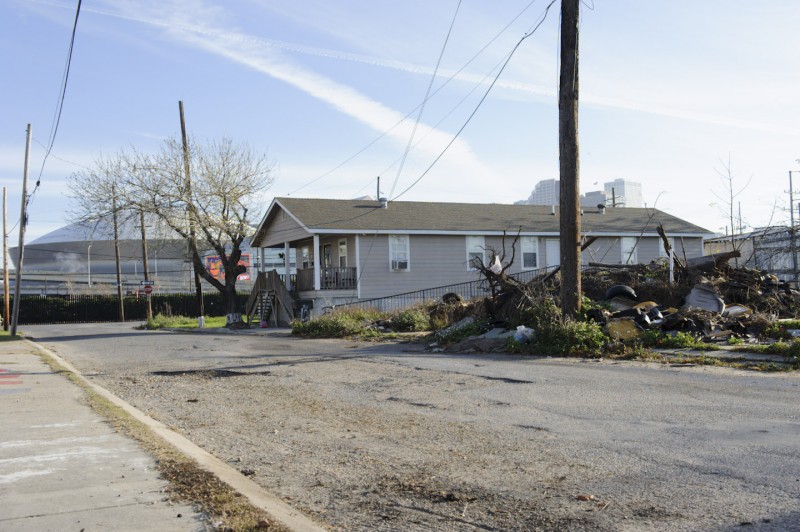
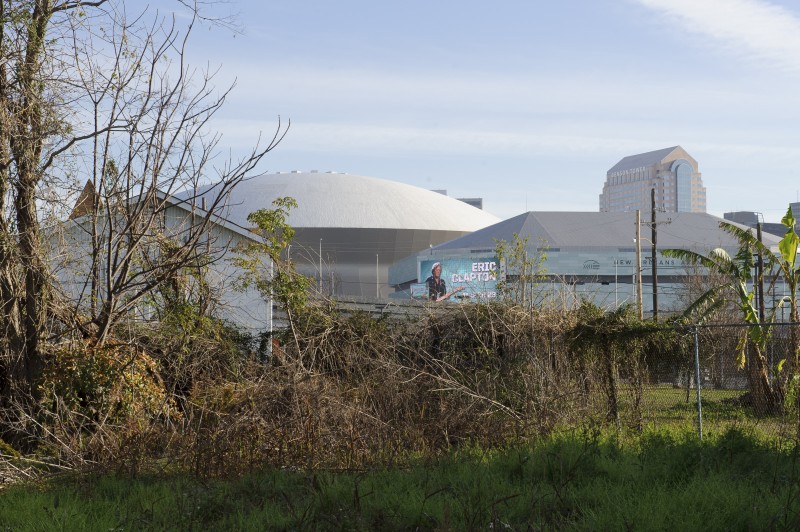



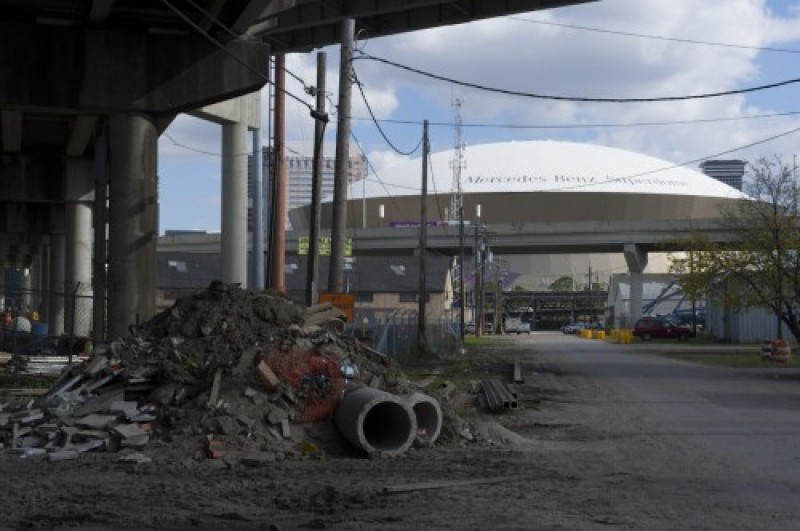
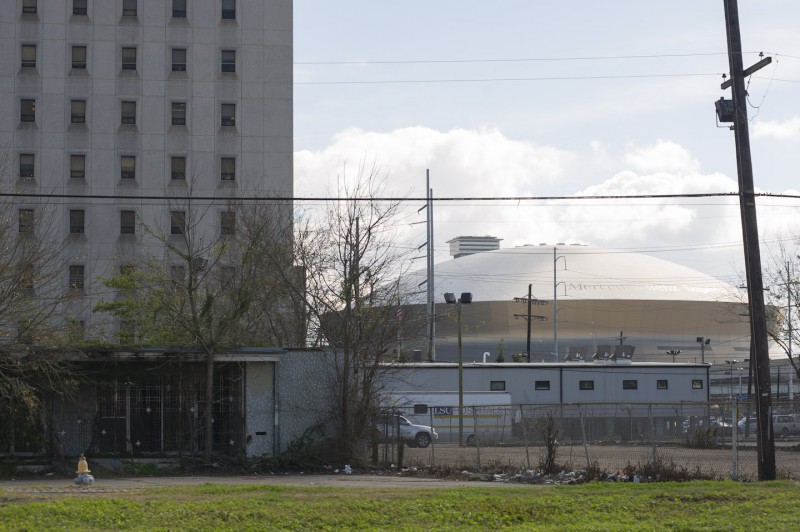
Wow…in the backdrop of the city plans to revitalize and give so many areas facelifts, this is an interesting contrast of vast and diversed canvas of the city. Frankly, it would’ve been nice to hear that $3-5M of the $45 Million was spent on other areas of the city (blighted areas, less affluent areas, etc)
I certainly hope we can get ALL of our city together soon.
On the right side of the tracks.
Dear Ms Gadbois,
I have been living happily in this neighborhood for a long time and though it may not be all cleaned up it is a great place to call home. In fact, you can keep all that glitz over there on the other side of the track because what we have over here is much much better. Where the Superdome stands was once a neighborhood with some very interesting residents. I bet the former residents wish they could walk back and see connections to their former neighborhood. It does not exist. No Ms. Gadbois I think you got it wrong. We are on the right side of the tracks and have connections to the same neighborhood that has been here for over 150 years. We do need more TLC and I wish you would use your pen to write a story to encourage young people to come and fix some of these houses up. We got more color in this neighborhood than any in the city and that is what makes New Orleans New Orleans. If you look on Dryades Street, you will see they are bringing that street back and doing so by saving the buildings and keeping things intact. Don’t YOU get fooled by all that shiny glitz on the other side of the tracks.
To is to Clio Contentment, I was born in the very neighborhood Ms Gadbious spotlighted in this article, and I’m MAD as hell, that she didn’t show the entire story of the NEGLECT taken place in Central City. Now, whatever you are talking about, I ain’t saw it yet. And the 150 years you talking about, you must be talking about on the other side of St. Charles, because in my neighborhood, we have NOTHING, but Crime to entertain us! Yeah, they fixing Dryades St up, but it don’t have nothing to do with ‘us’. You must be in that gang of whites who refuse to change Melpomene to MLK Blvd! So, I think Ms Gadbois short changed my neighborhood, because we don’t have no recreation center for our kids, and the only people profitting is the pastors in that neighborhood who play on the poor predicament to hustle apt. complexes and grant moneys, and city funding, while the people continue to suffer. We have NEVER enjoyed the financial gains of the Saints/Hornets, since they been across the street from us. Home Depot didn’t hire NONE of us! The construction going on over there, we don’t enjoy none of it, because the Wiggins hire their church members from downtown. There are no black-own businesses in that entire area, yet it’s majority black!!! All the resources thats designated for that area, go on one street: Oretha Castle Haley Blvd!! And I’m quite sure that’s illegal!!! So, Clio Contentment, enjoy you side of St. Charles, because as the picture prove, we ain’t got NOTHING to be proud of in Central City
Ah yes. Focus is a wonderful, interesting thing.
There is new landscaping at the Claiborne Bridge, must be proximity to the Brad Pitt Houses. But the bridge it self is a rusted mess. And just a few blocks back down Claiborne at 1501 Mazant there is a blighted leaning house and the sidewalk is not passable.
Focus is a wonderful, interesting thing.
It is my humble opinion that the city should have focused on this situation long ago. It appears that the city is truly divided in what the tourist will see and the reality of what every who lives in and around New Orleans sees. It
Jenel, focus is definitely a wonderful thing, and this story is about So. Claiborne Ave. in Central City, you are way downtown in the 9th Ward!! So, try to focus on the topic at hand and not the substance you are digesting.
Reading these comments is a curious thing… OC Haley Boulevard should be a point of pride for the residents of Central City, yet its redevelopment is looked upon with suspicion. Commenters bicker over neighborhood distinctions instead of recognizing common ground. It’s a little portrait of why progress takes a little longer in New Orleans.
Dear “Curious,” bickering isn’t why what you call “progress” takes a little longer in New Orleans. …And if you can’t understand why residents are suspicious of what’s going on with OC Haley, then you must have a vested interest. Your curiosity strikes me as disingenuous.
Anyway I realize this photoset is lakeside of OC Haley but I wish it could’ve included Professor Longhair’s house, which just lately has been looking even worse than it had been.
http://www.louisianalandmarks.org/?q=node/228
Great article Ms. Gadbois and Mr. Mulcahy, I am a resident of Central City and am proud to live here and think Ms. Clio Contentment was right. Most of my neighbors enjoy living in this neighborhood and keep the street in front of their houses clean. On OC Haley Blvd, some like all the non-profits and some wish we had more market rate businesses coming into the neighborhood. But all agree that the corruption that has existed over here has got to go. From our Pastors to City Council persons to US Senators the representatives of this neighborhood have not served the residents well. Thank you Lens for starting this discussion and keep it front and center and let any people know if they are thinking about saying they represent this area that we are watching them.
Central City near Clio between Home Depot and St. Charles won’t improve until the Mission is relocated to a place that makes more sense, like Bridge House’s new development on Earhart. Homeless shelters and halfway houses do not belong in residential neighborhoods.
Re: Jules B- I’m also genuinely curious about problems with the redevelopment on OC Haley. As a resident of Central City, having the new credit union and Zeitgeist cinema in our neighborhood is great and I was hoping for more businesses and nonprofits to come to this area, but I am open to hearing about other residents’ suspicion.
Re: James Orleans
That’s actually exactly where shelters and halfway houses should be- in mixed commercial/residential neighborhoods. Putting shelters in industrial zones hides them from the public view and decreases their effectiveness at housing people who would be sleeping outside downtown.
The huge lines and other problems associated with the Mission are because we don’t have enough shelters around the city, and the social and mental healthcare services that usually stop people becoming homeless in the first place have been slashed or closed completely all across Louisiana.